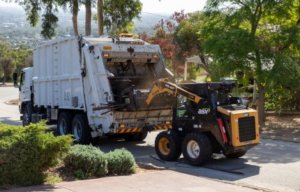Green Waste Collection Armadale includes grass clippings, leaves, twigs, shrubbery trimmings, weeds, and other organic materials. It excludes branches, palm fronds, and Christmas trees.
Sending this waste to landfills releases methane and carbon dioxide – potent greenhouse gases. A better option is to compost it. The process is not without problems.

Green waste collection involves diverting yard trimmings, food scraps, and coffee grounds from landfills, where they can create anaerobic conditions that release greenhouse gases. When this waste is composted instead, it decomposes in an oxygen-rich environment, greatly reducing methane production and other anaerobic conditions that harm the planet.
When collected correctly, organic waste can become a rich soil amendment that enriches gardens and landscapes. It helps retain moisture in the soil, increasing crop yields and reducing the need for fertilizer. In addition, it supports the growth of microorganisms in the soil that protect plants from disease and help them absorb nutrients more efficiently.
Most people who compost at home combine brown materials (like dead leaves, twigs, branches, and sawdust) with green materials (like grass clippings, fruit and vegetable scraps, and coffee grounds). When these two types of material are combined, they break down and decompose over time. The result is a thick, dark humus known as compost.
Professional rubbish removal services collect the compostable material in green bins and take it to a processing facility. There, workers sort the waste by hand to remove any trash or plastics that may have made their way into the bins. Once on-site, the waste undergoes a grinding process, preparing it for composting. The resulting waste is then placed into large piles, where it undergoes a heating process for three days. This kills any pests, weed seeds, and pathogens in the waste. The compost then goes through a final sorting process, which separates the waste by size. The smaller pieces return to the grinder, while the larger pieces enter the composting piles.
Aside from reducing anaerobic conditions that release methane, the composting process reduces leachate, which pollutes waterways and groundwater. In addition, it helps conserve space in landfills by lowering the volume of organic material that needs to be stored. Many municipalities use the co-composting of green and sewage waste as a safe alternative to traditional methods for disposing of sewage waste.
Recycling is the third component of modern waste reduction techniques. It converts recovered materials into new materials to reduce raw materials and energy use while reducing pollution and greenhouse gasses. In addition to reducing energy usage, recycling lowers the need for landfills and incinerators.
Recycling can be done either by repurposing existing products or remanufacturing them into new products. It is an effective method for preventing wasted materials from becoming garbage and decreasing the amount of metal ores, wood, and other natural resources used to make new products.
There are several ways to recycle: buy-back centers, drop-off centers, and curbside collection. The latter involves residents collecting their recyclables at the curb for pickup by a central agency. Several organizations specialize in sorting and processing green waste for reuse. They utilize various technologies, such as cameras, Artificial Intelligence (AI), compressed air, pneumatic arms, and even drones, to identify what can be recycled and what cannot.
Aside from the obvious environmental benefits, a green waste collection service provides additional convenience for residents. They do not have to invest in bins and other containers, nor will they be required to sort the waste. This helps prevent the spread of pests and diseases from contaminated food or other trash, which would otherwise be difficult to remove from an open bin.
Moreover, it prevents the waste from going to landfills, where methane is released into the atmosphere. Landfills are also a source of toxic heavy metals. Fortunately, many communities have programs that utilize methane extraction to produce renewable energy.
In addition to reducing the need for landfills, recycling reduces the amount of raw materials that are needed to make new products and lowers greenhouse gases from incineration and deforestation. It can also save money, as it can replace the need for buying expensive raw materials.
Green waste collection can help to improve a community’s overall environmental health. Still, it is important to remember that recycling is not the solution to all our problems. It is best used with other waste reduction methods, such as composting and avoiding excess packaging. In addition, it is a good idea to separate the different types of waste that can be recycled, such as metals, glass, plastics, paper, and cardboard. This will increase the efficiency of the recycling process and ensure that no waste is wasted.
Waste reduction is a key aspect of green waste collection and disposal. A company can significantly improve its sustainability and efficiency by decreasing the amount of waste it produces, thereby saving money on trash disposal fees. A simple way to measure the success of a waste reduction program is by tracking the amount of materials that are diverted from landfills over time. If the amount of material sent to landfills remains roughly the same, then the waste diversion initiative is working well.
Landfills are the number one source of methane, a greenhouse gas that traps heat in the atmosphere and contributes to global warming. Landfills also produce leachate, a liquid that pollutes waterways and groundwater, causing harm to humans and wildlife. Waste diversion reduces the amount of methane and other harmful gases produced by landfills and can be accomplished through several different techniques.
Many types of materials that are commonly sent to landfills can be repurposed or recycled instead. Packaging can be reused and recycled to extend its lifespan, while furniture like desks and chairs can be refurbished or sold through resale channels. Appliances and tools can often be repaired or donated to charities to extend their lives.
Another common form of waste diversion is energy recovery. This can be achieved through various methods, including incineration and anaerobic digestion. Using these processes, waste can be turned into a useful energy source, which will also help reduce landfill waste and associated environmental impacts.
Some countries, such as Japan and Sweden, have high rates of waste-to-energy diversion. These countries burn some of their municipal solid waste to generate energy, which is then used to power homes and businesses. Although this is not a perfect solution, it does help to reduce the amount of waste sent to landfills and provides a source of renewable energy.
Lastly, some green waste collected by rubbish removal services is mixed with sewage to create compost. This method decreases the amount of sewage incinerated or dumped into landfills and allows for the complete cycling of organic nutrients back into the environment.
In addition to cutting waste disposal costs, this green waste collection technique also benefits the environment by reducing greenhouse gasses. Resource recovery uses specialized incinerators to burn solid waste to create energy. This process reduces the amount of material sent to landfills by about 90 percent. It also produces a useful byproduct, such as biogas, which can be used as fuel for vehicles. It is a great alternative to burning solid waste in landfills, which creates toxic smoke and does not produce any energy.
Aside from the environmental benefits of resource recovery methods, this approach also offers companies a competitive advantage in attracting environmentally conscious customers. An increasing number of consumers base their business decisions on how environmentally friendly a company is. Resource recovery is one-way companies can appeal to this growing market, cut production costs, and improve their bottom line.
The green waste collection and processing industry is rapidly changing. More municipalities are offering viable composting programs, while the recycling of putrescible materials is increasing. It is even possible to recycle green waste into a product that can be reincorporated into the manufacturing cycle.
It is important to separate and collect green waste from other forms of trash because it has a different composition than general solid waste, such as metals or plastics. It is comprised of organic waste, such as yard and garden waste. This waste contains high nitrogen levels, which is helpful for many composting and nutrient-cycling processes. Green waste should not be mixed with brown waste, such as dried leaves or hay.
The Grasshopper Environmental team is proud of our work to help reduce the volume of green waste that ends up in landfills. We have diverted up to 90% of the Building and Demolition waste stream from landfills through our Green Waste Recycling program. This is a great achievement, especially given that the Building and Demolition sector accounts for 20.4 Mt of the total national waste stream. We have achieved this by utilizing innovative technology and working closely with our clients to develop customized waste management strategies.
